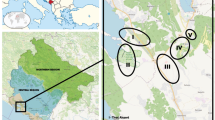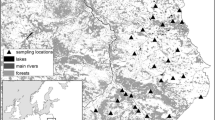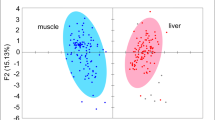Abstract
The grey wolf (Canis lupus) is a large carnivore species and a top predator in the ecosystems that it inhabits. Considering its role in food webs, wolves may be exposed to high concentrations of potentially harmful elements. Therefore liver samples from 28 legally hunted wolves were analyzed for concentrations of 16 elements using inductively coupled plasma optical emission spectrometry. The Mann–Whitney U test showed a significant difference between the genders only for Li, and there were no differences between individuals caught in different years. The majority of statistically significant correlations between element levels were positive, except for three cases. Compliance with several criteria for suitable bioindicator organisms imply that wolves may serve for monitoring environmental contamination.
Similar content being viewed by others
References
Becker PR (2000) Concentration of chlorinated hydrocarbons and heavy metals in Alaska artic marine mammals. Mar Pollut Bull 40:819–829
Biladžić N, Dežđek D, Sedak M, Đokić M, Šimić B, Rudan N, Brstilo M, Lisicin T (2012) Trace elements in tissues of wild carnivores and omnivores in Croatia. Bull Environ Contam Toxicol 88:94–99
Chapron G, Kaczensky P, Linnell JDC, von Arx M et al (2014) Recovery of large carnivores in Europe’s modern human-dominated landscapes. Science 346:1517–1519
Ćirović D, Gizajewska A, Jovanović V, Penezić A, Milenković M, Vujošević M, Blagojević J(2015) Concentration of selected trace elements in golden jackal (Canisaureus L., 1758) population from Serbia. Acta Zool Bulg 67:409–414
Djan M, Maletić V, Trbojević I, Popović D, Veličković N, Burazerović J, Ćirović D(2014) Genetic diversity and structuring of the grey wolf population from the Central Balkans based on the mitochondrial DNA variation. Mamm Biol 79:277–282
Flaten TP, Andersen LH, Holsen AMH, Ottemo VG, Pedersen HC, Steinnes E, Lierhagen S, Jenssen BM (2008) A nationwide survey of trace elements in lynx, wolverines, wolves, and brown bears in Norway. Cell Biol Toxicol 24(Supple 1):6–7
Gall JE, Boyd RS, Rajakaruna N (2015) Transfer of heavy metals through terrestrial food webs: a review. Environ Monit Assess 187:201. https://doi.org/10.1007/s10661-015-4436-3
Gamberg M, Braune BM (1999) Contaminant residue levels in arctic wolves (Canis lupus) from Yukon Territory. Can Sci Total Environ 243:329–338
Gnamuš A, Byrne AR, Horvat M (2000) Mercury in the soil-plant-deer-predator food chain of a temperate forest in Slovenia. Environ Sci Technol 34:3337–3345
Hernández-Moreno D, de la Casa Resino I, Fidalgo LE, Llaneza L, Soler Rodríguez F, Pérez-López M, López-Beceiro A (2013) Noninvasive heavy metal pollution assessment by means of Iberian wolf (Canis lupus signatus) hair from Galicia (NW Spain): a comparison with invasive samples. Environ Monit Assess 185:10421–10430
Hoffmann SR, Blunck SA, Petersen KN, Jones EM et al (2010) Cadmium, copper, iron, and zinc concentration in kidneys of grey wolves, Canis lupus, from Alaska, Idaho, Montana (USA) and the Northern Territories (Canada). Bull Environ Contam Toxicol 85:481–485
Holyan J, Boyd DK, Mack CM, Pletscher DH (2005) Longevity and productivity of three wolves, Canis lupus in the wild. Can Field Nat 119:447–448
Institute for nature conservation of Serbia (2013) Special nature reserve “Peštersko polje”, conservation proposal. Belgrade, p 127
Kaczensky P, Chapron G, von Arx M, Huber D, Andrén H, Linnell J (2012) Status, management and distribution of large carnivores—bear, lynx, wolf and wolverine—in Europe, part 1. European Commission, p 72
Lazarus M, Sekanović A, Orct T, Reljić S, Kusak J, Jurasović J, Huber Đ (2017) Apex predatory mammals as bioindicator species in environmental monitoring of elements in Dinaric Alps (Croatia). Environ Sci Pollut Res. https://doi.org/10.1007/s11356-017-0008-0
Mann RM, Vijver MG, Peijnenburg WJGM (2011) Metals and metalloids in terrestrial systems: bioaccumulation, biomagnification and subsequent adverse effects. In: Sánchez-Bayo F, van den Brink PJ, Mann RM (eds) Ecological impacts of toxic chemicals. Bentham e-Books, pp 43–62
Mech LD (1988) Longevity in wild wolves. J Mammal 69:197–198
Millán J, Mateo R, Taggart MA, López-Bao JV, Viota M, Monsalve L, Camarero PR, Blázquez E, Jiménez B (2008) Levels of heavy metals and metalloids in critically endangered Iberian lynx and other wild carnivores from Southern Spain. Sci Total Environ 399:193–201
Paunović M, Ćirović D, Milenković M (2008) Status, management and conservation of large carnivores in Serbia. In Conference paper of Coexistence of large carnivores and humans: threat or benefit? pp 111–117
Pérez-López M, Soler Rodríguez F, Hernández-Moreno D, Rigueira L, Fidalgo LE, López Beceiro A (2016) Bioaccumulation of cadmium, lead and zinc in liver and kidney of red fox (Vulpes vulpes) from NW Spain: influence of gender and age. Toxicol Environ Chem 98:109–117
Randi E (2011) Genetics and conservation of wolves Canis lupus in Europe. Mamm Rev 41: 99–111
Rodriguez JH, Wannaz ED, Salazar MJ, Pignata ML, Fangmeier A, Franzaring J (2012) Accumulation of polycyclic romatic hydrocarbons and heavy metals in the tree foliage of Eucalyptus rostrata, Pinus radiata and Populus hybridus in the vicinity of a large aluminium smelter in Argentina. Atmos Environ 55:35–42
Sergio F, Caro T, Brown D, Clucas B, Hunter J, Ketchum J, McHugh K, Hiraldo F (2008) Top predators as conservation tools: ecological rationale, assumptions, and efficacy. Annu Rev Ecol Evol Syst 39:1–19
Shan Y, Tysklind M, Hao F, Ouyang W, Chen S, Lin C (2013) Identification of sources of heavy metals in agricultural soils using multivariate analysis and GIS. J Soils Sediments 13:720–729
Shore RF, Casulli A, Bologov V, Wienburg CL, Afsar A, Toyne P, Dell’Omo G (2001) Organochlorine pesticide, polychlorinated biphenyl and heavy metal concentration in wolves (Canis lupus L. 1758) from north-west Russia. Sci Total Environ 280:45–54
Stronen AV, Jędrzejewska B, Pertoldi C, Demontis D, Randi E, Niedziałkowska M, Pilot M, Sidorovich VE, Dykyy I, Kusak J, Tsingarska E, Kojola I, Karamanlidis AA, Ornicans A, Lobkov VA, Dumenko V, Czarnomska SD (2013) North-south differentiation and a region of high diversity in European wolves (Canis lupus). PLoS ONE 8(10):e76454
Turković M, Bukumirović D, Radeka G, Mušović S (2012) Potentiality and prospects of underground coal mining in the Sjenica coal basin. Min Eng 2:115–124
Vihnanek Lazarus M, Sekovanić A, Kljaković-Gašpić Z, Orct T, Jurasović J, Kusak J, Reljić S, Huber Đ (2013) Cadmium and lead in grey wolf liver samples: optimisation of microwave-assisted digestion method. Arh Hig Rada Toksikol 64:395–403
Yilmaz AB, Sangün MK, Yağlioğlu D, Turan C (2010) Metals (major, essential to non-essential) composition of the different tissues of three demersal fish species from İskenderun Bay, Turke. Food Chem 123:410–415
Zhou Q, Zhang J, Fu J, Shi J, Jiang G (2008) Biomonitoring: an appealing tool for assessment of metal pollution in the aquatic ecosystem. Anal Chim Acta 606:135–150
Acknowledgements
We acknowledge the support provided by Projects No. TR31009 and 173045, funded by Ministry of Education, Science and Technological Development of the Republic of Serbia. The authors would like to thank dr Miroslav Nikolić and dr Ljiljana Kostić-Kravljanac for their help during heavy metal analysis, and to anonymous reviewers for providing helpful comments and suggestions that improved the quality of the paper.
Author information
Authors and Affiliations
Corresponding author
Rights and permissions
About this article
Cite this article
Subotić, S., Višnjić-Jeftić, Ž., Penezić, A. et al. Concentrations of Selected Elements in Liver Tissue of Grey Wolves (Canis lupus) from Serbia. Bull Environ Contam Toxicol 99, 701–705 (2017). https://doi.org/10.1007/s00128-017-2209-0
Received:
Accepted:
Published:
Issue Date:
DOI: https://doi.org/10.1007/s00128-017-2209-0




